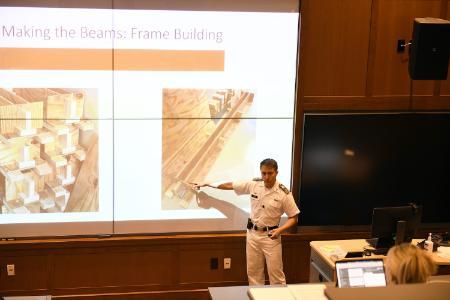Starting at the Drawing Board: Cadet Research Focuses on Infrastructure

LEXINGTON, Va. March 26, 2023 — Infrastructure is the basic physical systems of an area, such as roads, bridges, tunnels, and water and sewer systems. According to the American Society of Civil Engineers, America’s infrastructure report card for 2021 earned a grade of C minus, due to water main breaks, wear and tear on roads, and aging bridges throughout the country. Colin Butler '23, a civil engineering major at Virginia Military Institute, has conducted a year-long research project on concrete support beams. He presented his findings in his senior thesis titled, “High Strength Fiber Reinforced Concrete and its Application in Composite Beams” during Honors Week, held March 20-28.
Butler described the difference between high strength fiber reinforced concrete (HSFRC) and normal concrete.
“Normal concrete is made when sand (fine aggregate) and stone (coarse aggregate) are mixed together with cement, which binds the aggregate together. HSFRC contains more fine aggregate and small fibers usually made of steel or polymer, instead of coarse aggregate (stone) and requires less water to mix. It is at least 1 ½ times stronger than normal concrete and has a minimum compressive strength of 6,000 psi (pounds per square inch) or more. HSFRC is regarded as the ‘step’ between normal and ultra-high-performance concrete (UHPC),” he said.
Butler started his research where most research starts — at the drawing board. With complex mathematical formulas, he designed a 3.5 inch by 7 inch beam made of normal concrete, with a half-inch thick HSFRC laminate layers on either the top, bottom, or both.
"My hypothesis was that the beams with the HSFRC reinforced layers on top and bottom would withstand greater pressure than beams made exclusively of normal concrete (the control beam), as well as beams with laminate layers solely on the top, and beams with laminate layers solely on the bottom,” he stated. 
He built wood frames in which to pour the wet concrete to form the beams. He made a total of 12 beams, three of each type: the control, top reinforced, bottom reinforced, and top-bottom reinforced. He covered each form with burlap and allowed them to cure for 28 days. He then treated the surface of each beam with muriatic acid, which dissolves cement paste on the surface of the beam, and used a power drill with a metallic brush attachment to flick away debris in order to increase surface area, and allow for a stronger bond between the normal concrete and the HSFRC.
Butler tested the beams with an applied load in the engineering lab. The results both confirmed his hypothesis, but presented revelations as well. As predicted, the top-bottom beams outperformed the other three types, but Butler was surprised that the control beam outperformed both the top reinforced and the bottom reinforced.
Butler concluded his presentation by recommending further research and suggested laminate thickness, rather than laminate location, be examined. He also suggested using commercially provided UHPC.
Maj. Kacie D’Alessandro, assistant professor in the Department of Civil and Environmental Engineering and Butler’s advisor said, “Butler’s honors project expands on prior research accomplished here at VMI. We had previously only considered the high strength laminate on the bottom of the beam, so it has been exciting to see what happens when the location of the laminate is changed. This expanded research on composite beams could lead to future applications in new construction or repair of concrete structures,” she said.
Butler will present his research, alongside Jack Cross '23, a cadet who worked on mix development of high strength concrete, at the American Concrete Institute (ACI) Concrete Convention in San Francisco, California, in April.
Butler is from Fairfax Station, Virginia, where he attended South County High School. He is the son of Dawn and Michael Lehrfeld, and the grandson Lloyd Thacker who graduated from VMI in 1959. He is majoring in civil engineering with minors in physics and applied mathematics. He plays the trumpet in the VMI Brass quintet, is a bugler, and regimental drum major. After graduation, he will commission in the Army as an aviation officer.
Marianne Hause
Communications & Marketing
VIRGINIA MILITARY INSTITUTE
.svg)
.png)